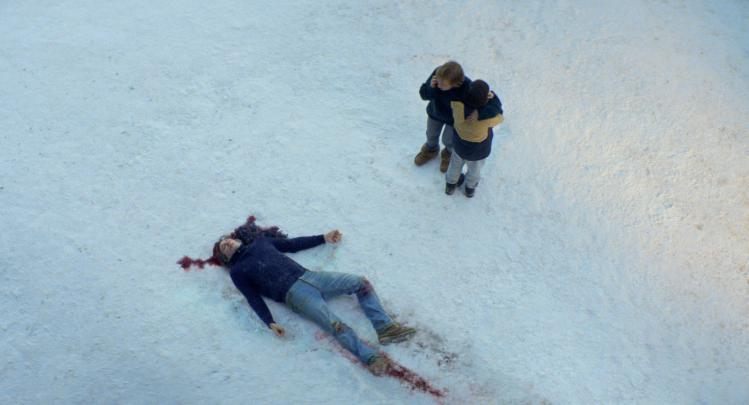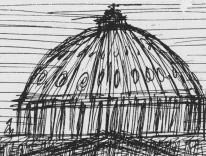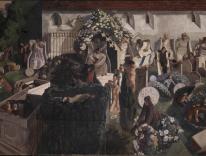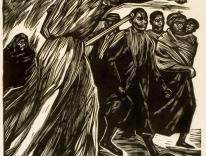
The trailer for the classic 1959 legal thriller Anatomy of a Murder is strange. It opens not with scenes from the movie but in a courtroom, where a bailiff announces the film and the director, Otto Preminger, “swears in” the actors (including Duke Ellington on piano), asking them to confirm that they “have done their job in the picture to the best of their ability.” Then, John Voelker, the film’s technical advisor and a defense attorney who authored the book on which it was based, interrupts to object that there is no jury present. Preminger, turning toward the camera, reassures him: “Our jury is not just twelve men and women in a box. Our judge and jury sits out there, the millions and millions of people in the theater.”
Motion pictures and criminal trials have more in common than might be expected. As Preminger suggests, they both take place in front of an (ideally) mute audience who are asked, implicitly or explicitly, to render judgment. And they both offer a collection of material (testimony or shots) that is limited by the perspective and senses—especially sight—by which human beings grasp the world. Opposing lawyers, like battling directors, put this material together to make two competing narratives. Movies and trials both hold the promise of truth; they seem capable of providing objective knowledge—from the outside, as it were. But they ultimately fall short. They turn out to be of the world, not outside it.
These parallels help explain why the courtroom drama numbers among film’s original genres; the first legal thriller was, by some accounts at least, 1907’s Falsely Accused!, in which an inventor turns up dead and the prime suspect is his daughter. But few, if any, courtroom dramas have taken as much advantage of these affinities and the epistemological questions around them as Justine Triet’s Anatomy of a Fall, winner of the Palme D’Or at last year’s Cannes Film Festival.
In Triet’s film—which draws inspiration and its title from Preminger’s—the jury and audience are asked to determine whether the writer Sandra Voyter (played by an outstanding Sandra Hüller) is falsely accused of killing her husband Samuel. A teacher and aspiring writer himself, Samuel is found dead outside the family’s isolated chalet in the French Alps. The evidence as to whether he jumped or was pushed is ambiguous (an accidental fall is deemed implausible), and there are no witnesses to the event. The only witness to the couple’s deteriorating relationship (the film’s other “fall”) is their son, Daniel, who was partially blinded after being hit by a motorcycle years before, an accident for which Samuel blamed himself and which precipitated the couple’s marital problems.
The film opens shortly before Samuel’s death with Sandra talking to a grad student, Zoé, who has come to the house to conduct an interview for her thesis. “Well,” Sandra asks, “what do you want to know?” But it’s clear from the start that Sandra is not an open book. Drinking wine in the middle of the day, she quickly deflects Zoé’s attention away from her autofiction and its relationship to her son’s accident and redirects it back toward the student. Sandra might even be flirting with her. But before we can learn much about either of them, the interview is abruptly interrupted. Samuel, who is up in the attic installing insulation, has been playing obnoxiously loud music that makes conversation impossible. Something is off. Zoé leaves, and a short while later, when Daniel and his dog return from a walk, they find Samuel dead on the snow below the attic window.
The aborted interview introduces the film’s major motif: thwarted attempts to know. No matter what methods—scientific, literary, or psychological (a psychic is even mentioned at one point)—are brought to bear on Sandra and on her husband’s death, we, like the other characters, seem destined to remain in the dark. The autopsy turns up inconclusive results. Blood-splatter analysts develop scientifically compelling but mutually exclusive theories as to the origins of the blood on the side of the shed next to Samuel’s body. Samuel’s psychiatrist is called to weigh in on the possibility of a suicide, but he and Sandra give equally plausible and incompatible accounts of Samuel’s mental struggles. The psychiatrist thinks Sandra placed the burden of Daniel’s accident solely on Samuel, who was supposed to pick their son up from school that day but was engrossed in his writing and so sent a babysitter instead. After that, according to the psychiatrist, Sandra “castrated” Samuel, making him “pay for the accident” by giving up his writing, whose success, he opines, she wouldn’t have been able to bear. Sandra, in reply, paints a portrait of a frustrated writer now past forty, who was plagued by self-doubt and shame and felt the need to blame his successful wife for his troubles.
Throughout the film, Sandra insists not only on her innocence but also on the dangers of elevating mere parts of reality into emblems of the whole, as trials often do. She calls the psychiatrist’s conversations with Samuel a “little part of the whole situation” and even casts doubt on the possibility of any clear view of the troubled marriage. “A couple is a kind of chaos,” she claims: “Everybody is lost.” In a masterfully filmed scene, the court listens to an audio recording of a brutal argument the couple had the day before Samuel’s death. Sandra says it is “not reality,” but “a part of it, maybe.” It “may seem like irrefutable proof, but actually warps everything.”
In a critical review on the New Yorker’s website, Richard Brody faults the film for an inattention to detail and the lack of an “outside perspective” on the film’s events. He asks, for example, why we don’t learn how much the lawyer is charging Sandra. But this constricted view is, of course, the point. Triet and her cinematographer, Simon Beaufils, create an “airtight” (Brody’s word) atmosphere in order to emphasize our inability to get outside things. Instead of using the camera to construct a false sense of objectivity, they emphasize the partiality and multiplicity of perspectives. Sometimes we are with Sandra, sometimes with Daniel, sometimes even with Snoop, the family dog. Sometimes we see things through the shaky handheld cameras of the news media covering the case; sometimes we see clean reenactments of the facts as one side or the other would like them to be perceived.
In the tensest courtroom scenes, the camera zooms and swings bewilderingly between characters and sometimes even seems lost itself. Unlike the American adversarial legal system, the more freewheeling French inquisitorial system (rendered here, one suspects, with a fair amount of artistic license) gives judges a more active investigative role and allows multiple witness to be heard from at once. Triet presents the trial as a process designed to arrive analytically at the truth but unable to do so. Brody also complains that Triet omits jury selection—and indeed the jury is kept noticeably out of frame and out of focus throughout the film—but perhaps that’s because the jury is us.
In his book The Rings of Saturn, the German writer W. G. Sebald offers a famous interpretation of Rembrandt’s painting The Anatomy Lesson, which documents the 1632 public dissection of Aris Kindt, a thief who was hanged. In the painting, the surgeon, Dr. Nichoelas Tulp, uses forceps to hold up the tendons in Kindt’s left arm, demonstrating how the left hand is controlled. But, as Sebald’s narrator points out, many of Tulp’s colleagues are not looking at Kindt’s arm. Their gaze falls instead on an anatomy textbook facing them, visible in the bottom right corner of the painting. Strangely, the narrator informs us, Kindt’s left arm is enlarged in comparison to the right, and on closer inspection, it is clear that the arm is not depicted accurately at all. The left palm is facing upward, but the tendons we see belong on the back of the right hand.
This, the narrator tells us, is not an oversight. The “error” is Rembrandt’s way of criticizing the anatomists and the cruelly rationalistic assumptions behind their practice. Rembrandt transposes the textbook’s anatomical schema onto the real arm to show how Tulp and his colleagues had allowed an abstract representation to overwhelm the real man in front of them.
That unshapely hand signifies the violence that has been done to Aris Kindt. It is with him, the victim, and not the Guild that gave Rembrandt his commission, that the painter identifies. His gaze alone is free of Cartesian rigidity. He alone sees that greenish annihilated body, and he alone sees the shadow in the half-open mouth and over the dead man’s eyes.
Anatomy of a Fall suggests a similar violence being done to its protagonist when her marriage and personality are dissected in the courtroom. Taken out of context, the recorded marital quarrel, a suggestive passage from one of Sandra’s novels, and some unconventional personality traits threaten to create a distorted image. As in Saul Bass’s memorable drawing of a disconnected body for Anatomy of a Murder’s title design, anatomy deforms, flattens, and leaves gaps. The obsessive analysis of the available evidence—whether in the surgery, the editing bay, or the courtroom—can conceal as much as it reveals. The more we search for the truth in the abstract dissection of the parts, the more the whole escapes us.
Just as Rembrandt tried to redeem Kindt, Sandra forcefully resists the prosecuting attorney’s attempts to fit her into the prefabricated model of a cold female careerist who pushes aside her family in favor of artistic fulfillment and recognition. She even refuses her own attorney’s attempt to turn her dead husband into the stereotype of a failed artist. Triet and Hüller have created a striking character, at once authentic and impenetrable, who refuses to be either victim or monster, but still leaves us, if we squint, able to see both.
The self-defense Sandra offers can be read as a defense of the integrity of an individual life amid the culture of forced and fragmentary publicity to which we are all now, to some degree, subject. We are surveilled by the platforms on which we conduct much of our lives; we are recorded by family, friends, and strangers; we are over-scrutinized and we self-censor, fearful that we may someday be haunted by a forgotten misstep; we feel compelled to make out of the scattered ephemera of our lives an appealing presentation to a judgmental public. Who we really are is swamped by abstract data skimmed off our surfaces. Paradoxically, Anatomy of a Fall manages to make an author of autofiction into a hero of privacy.
What are we to do when we reach the limits of our ability to know? The audience ends up facing this question through the partially blind Daniel, who wants so much to see who his mother really is. A court-appointed companion tells him, after he pleads for guidance, that when we lack a factual basis, “all we can do is decide.” This existentialist advice—to make, in effect, a leap of faith—puts practical reason above the theoretical. It makes clear that judgment ultimately involves the kind of responsibility that cannot, in good faith, be passed off to an impersonal, faux-objective authority. “Truth,” Kierkegaard wrote, “is not a sum of statements, not a definition, not a system of concepts, but a life.”


